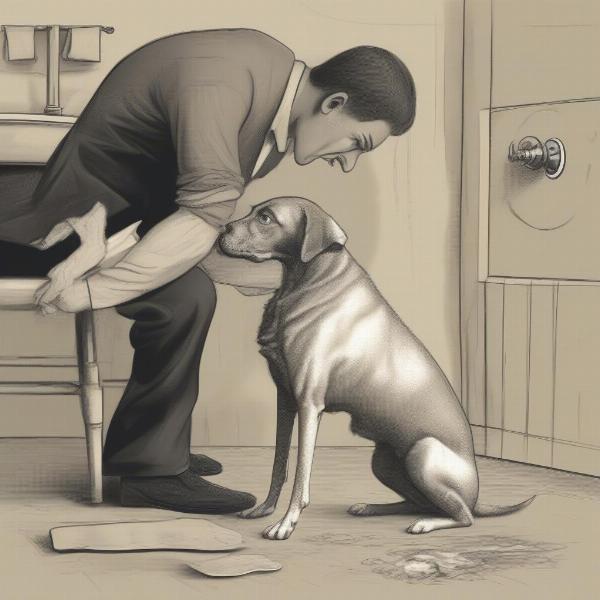If your dog hasn’t peed or pooped in 24 hours, you’re likely worried. It’s understandable – changes in bathroom habits can signal a health issue. While not always a cause for immediate panic, it’s crucial to understand the potential reasons and know when to seek veterinary attention. This article will guide you through the possible causes, symptoms to watch out for, and what steps to take if your dog is experiencing this issue.
Is your dog straining to urinate or defecate? Are they showing signs of discomfort or lethargy? These could be indicators of a more serious problem. Let’s delve into the reasons why your dog might be experiencing this and what you should do. From simple constipation to more serious conditions like urinary blockages, we’ll cover the spectrum of possibilities. We’ll also discuss preventative measures you can take to ensure your furry friend stays healthy and regular.
Understanding Why Your Dog Isn’t Eliminating
Several factors can contribute to a dog’s inability to urinate or defecate within a 24-hour period. Sometimes, it’s as simple as a change in diet or a lack of exercise. Other times, it could indicate a more serious underlying medical condition. Let’s explore some of the common culprits:
Constipation
Constipation is a frequent cause of infrequent bowel movements. A diet lacking in fiber, dehydration, or even stress can lead to constipation. Observe your dog for signs like straining, hard stools, or a lack of appetite.
 Dog Constipation Symptoms
Dog Constipation Symptoms
Urinary Tract Infections (UTIs)
UTIs can make urination painful and difficult, causing your dog to avoid going altogether. Look for signs like frequent squatting, small amounts of urine, or blood in the urine.
Blockages
Blockages, whether in the urinary tract or digestive system, are serious and require immediate veterinary attention. These can be caused by foreign objects, stones, or tumors.
Dehydration
Dehydration can lead to both constipation and difficulty urinating. Ensure your dog has access to fresh, clean water at all times.
Stress and Anxiety
Changes in routine, new environments, or even loud noises can stress a dog out, affecting their bathroom habits.
When to Seek Veterinary Care
While a single day without peeing or pooping might not always warrant a trip to the vet, it’s crucial to monitor your dog closely. If you notice any of the following, seek immediate veterinary attention:
- Straining to urinate or defecate without success
- Vomiting
- Lethargy
- Loss of appetite
- Abdominal pain or swelling
- Blood in urine or stool
Preventing Elimination Problems
Maintaining your dog’s health involves proactive steps to prevent these issues from arising in the first place:
- High-Fiber Diet: A diet rich in fiber can help regulate bowel movements.
- Hydration: Ensure your dog always has access to fresh water.
- Regular Exercise: Physical activity stimulates bowel movements.
- Routine Vet Checkups: Regular checkups can help identify and address potential problems early.
Conclusion
If your dog hasn’t peed or pooped in 24 hours, don’t ignore it. While it might be a minor issue, it could also indicate a more serious health concern. Monitoring your dog’s behavior and seeking veterinary care when necessary are crucial steps to ensuring their well-being. Remember, prevention through a healthy diet, regular exercise, and adequate hydration is always the best approach.
FAQ
- Is it normal for a dog to not poop for a day? While not ideal, it’s not always a cause for immediate concern. However, monitor your dog closely for other symptoms.
- How can I encourage my dog to poop? Try a short walk, or add a bit of pumpkin puree to their food for added fiber.
- What are the signs of a urinary blockage? Straining to urinate, frequent squatting, and crying or whining while trying to urinate are all signs of a potential blockage.
- Can stress cause a dog to not poop? Yes, stress and anxiety can definitely affect a dog’s digestive system and lead to changes in bowel movements.
- How much water should my dog drink per day? Generally, a dog should drink about an ounce of water per pound of body weight daily.
- What should I do if my dog hasn’t peed in 24 hours? If your dog hasn’t urinated in 24 hours, consult a veterinarian immediately, as this can be a sign of a serious medical condition.
- What are some high-fiber foods for dogs? Pumpkin, sweet potatoes, and carrots are good sources of fiber for dogs.
Related Articles (If any):
- [Link to relevant article 1 (if applicable)]
- [Link to relevant article 2 (if applicable)]
About ILM Dog:
ILM Dog is your trusted international resource for expert dog care and breed information. We cover a range of topics, from health and nutrition to training and behavior, empowering owners to provide the best care for their companions. Whether you’re navigating puppyhood, managing a senior dog, or seeking advice on nutrition and grooming, ILM Dog offers reliable, practical guidance. Contact us today for expert advice and personalized recommendations. Email: [email protected], Phone: +44 20-3965-8624.